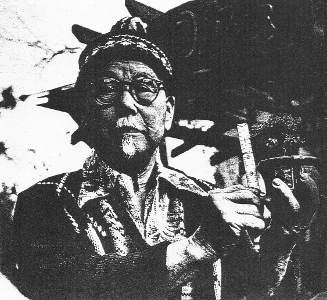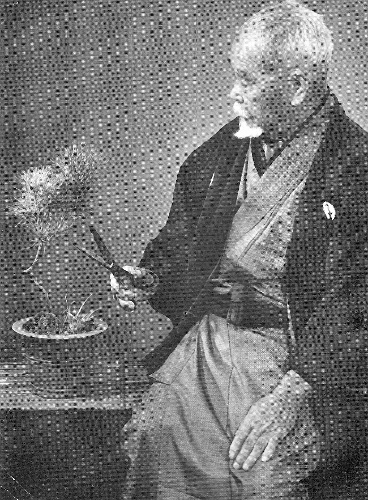| 1 |
1917 -- Masayuki Fujio was born. [He would serve as an MP for
31 years and, working in the Diet, would serve as the Minister of Labor
and the Minister of Education. He would end his career as a
politician in 1996 and be rewarded with the Grand Cordon of the Order of
the Rising Sun for his duties. A well-known bonsai enthusiast, in 1989
he would make a speech at the World Bonsai Convention in Omiya to announce
the establishment of the World Bonsai Friendship Federation. A former
consultant for the Nippon Bonsai Association, he would support many of their
projects for over 20 years and be elected as the president of the association in
2004.]
("Masayuki Fujio Becomes President of the Nippon Bonsai Association," by Kazuya
Morita, Editor, Nippon Bonsai Association magazine, Japan Region, World
Bonsai Friendship Federation,
http://www.bonsai-wbff.org/rjapan.shtml, accessed 05/31/04.)
1951 -- Ernest Francis Coe died at age 84 in Miami, FL. (Born on March 21, 1866 in New Haven, Connecticut, he attended Yale University's School of Fine Arts from 1885 to 1887. Affectionately known as Tom by his friends, this 6-foot-tall, spare, courtly gentleman earned post education in landscape architecture in Japan and Europe, and became one of New England's best and brightest in landscape design. He was a distinguished member of the American Society of Landscape Architects and of the Committee for National and State Parks and Monuments. As President of Elm City Nursery of New Haven, CT in 1911 Coe had some dwarf trees imported from Japan (probably from the Yokohama Nursery), and described an experience that was probably typical for the time: "Their journey over land and sea covered three months, but so skilfully [sic] had they been packed that they appeared but little the worse for their long subjection..." His article "Keeping Japanese picture-plants alive" was published in Garden Magazine in 1923. In 1925 he presented the collection of 32 Japanese bonsai, representing 21 species of trees and shrubs, to the Brooklyn Botanical Garden, where they formed the basis for one of the oldest continuous public displays of bonsai in the United States. To most bonsai enthusiasts, this was Ernest F. Coe's claim to fame. His greatest achievement, however, was yet to occur. Rumors of the Florida boom, with a great building of estates that would need landscaping, spoke to the unsatisfied adventurousness of his Yankee nature. So he donated his trees apparently because of this. Then Coe and his wife Anna moved to Miami in 1925 to make their home in the newly annexed city of Coconut Grove. He was ready to position himself and his services to the wealthy Palm Beach society to the north up the eastern coast. This is where he met Harold H. Bailey, the organizer of a group of Miami intellectuals who were the interested in the Everglades. Coe wanted to see these Glades firsthand, and upon that first gaze, a "white fire of revelation" took hold. From that moment on, he was her unyielding champion in words and deeds. She became his home away from home -- a rare and misunderstood treasure he vowed to protect. He was overwhelmed with the natural beauty and wildlife of the Cape Sable and Ten Thousand Islands area. He wanted to find some way to protect the bird rookeries and hammocks, and the establishment of a national park seemed like an ideal solution. In 1928 he created the Tropical Everglades National Park Association (later Everglades National Park Association). As an official of this association he persistently and almost single handedly pushed for the establishment of the park. In 1928 Coe wrote to Stephen T. Mather, first Director of the National Park Service, outlining a proposal for a national park to be located within the lower everglades of south Florida. A subsequent meeting took place and from this meeting legislation to create Everglades National Park was introduced by Senator Duncan U. Fletcher of Florida, in December of 1928. An inspection party came to Miami in 1930 to decide on areas for inclusion. One of those who participated was Marjory Stoneman Douglas (1890-1998), who would later write the 1947 The Everglades: River of Grass, which has become a classic about the park and its conservation movement. Legislation was approved May 25, 1934 and was signed by President Roosevelt on May 30, 1934. It took another thirteen years to acquire the land and define the boundaries of the new park. (Meanwhile, Coe's wife Anna died in July 1941.) After WWII, John Pennekamp, the editor of the Miami Herald, who knew both Mrs. Douglas and Mr. Coe as conservation kindred spirits -- Mrs. Douglas was also a Herald columnist -- revived the Everglades National Park Commission. Mr. Pennekamp learned that 900,000 acres belonged to the state and then convinced the public-spirited Barron Collier family to donate additional lands to comprise the park. It had taken five Florida governors, three U.S. presidents and $2 million dollars, but finally Everglades National Park became a reality under President Harry S Truman on December 6, 1947. That year, Coe was voted Outstanding Citizen of the Year by the City of Miami. In 1948 he was awarded the George Robert White medal of honor, the highest horticultural honor in the United States, and the Thomas Barbour medal for conservation by the Fairchild Tropical Garden. He took them with quiet thanks and went home again.) [On December 6, 1996 to prepare for its 50th Anniversary, Everglades National Park would christen its new visitor center the "Ernest F. Coe Visitor Center," in honor of this man who dedicated his life to the preservation of the everglades.] 
Ernest F. Coe, November 6, 1947.
("Ernest F. Coe, Father of the Everglades," National Park Service,
http://www.nps.gov/ever/historyculture/ernestcoe.htm;
Elias, Thomas S. "History
of the Introduction and Establishment of Bonsai in the Western World," pp. 28-29, 55; Del Tredici, Peter
Del Tredici, Peter "From Temple to Terrace, The Remarkable Journey of the Oldest Bonsai in America"
(Jamaica, MA: Arnold Arboretum, Harvard University: Arnoldia 64/2-3, 2006); Anagnostakis, Dr. Sandra L.
Chestnuts and the Introduction of Chestnut Blight
(11/97) lists Elm City Nursery, New Haven, CT as offering via mail order in 1901 these types of chestnut tree at
the following prices: American $0.50-1.00; Spanish $0.25-1.00; 'Numbo' $1.50; Japanese $0.50-1.00 ; Elm City
nursery is mentioned as being still in existence in 1927 on pg. 18 of
T.C. Memo. 1999-358 United States Tax Court
John H. Miner and Holly K. Miner, Petitioners v. Commissioner of Internal Revenue, Respondent, however per
a 1922 stock certificate for "The Elm City Nursery Company/Woodmont Nurseries Incorporated" (incorporated in
1901 under the laws of the State of Connecticut) seen on 25 Dec 2009 offered on e-bay as
item 270413179714 through 17 Jan 2010, neither the signing secretary nor president was Coe. ;
Bolin, Lois "A man to remember: Ernest Coe, 'Forgotten Father of the Everglades'," Special to Florida
Weekly,
http://naples.floridaweekly.com/news/2009-05-14/undercover_historian/007.html;
The Oklahoma Memorial, Clair Engle Lake, and Marjory Stoneman Douglas Wilderness: Hearing before the
Subcommittee on National Parks, Historic Preservation, ... S. 895 ... S. 931 ... July 17, 1997 (S. hrg)
http://books.google.com/books?id=jfQRAAAAIAAJ&q=%22Ernest+Francis+Coe%22&dq=%22Ernest+Francis+Coe%22&lr=&cd=14,
pg. 3; Douglas, Marjory Stoneman "The Forgotten Father," 1974 in Audubon Magazine,
http://www.evergladesonline.com/50years/forgot.htm)
SEE ALSO: Feb 7, Aug 3.
(Photo by Murnor Studio. Credit: Historical Museum of Southern Florida, Miami News Collection, image no. 1989-011-19897, per http://www6.miami.edu/english/msdouglas/MSDpeers.html) SEE ALSO: Jun 5 1965 -- The Santa Anita Bonsai Society became officially effective as an organization today. (Khan Komai's Bonsai Nursery in Temple City, east of downtown Los Angeles, had been the site of a monthly Study Group led by volunteer instructor Jim Barrett since 1961. Khan's was one of the few widely scattered places for any type of bonsai instruction at the time, plus the two established bonsai groups -- the California and Los Angeles Bonsai Societies -- conducted their meetings mostly in Japanese. The Nursery had opened in 1958 and Jim had first visited it that Autumn. This Study Group had the inherent dichotomy of trying in the same format to satisfy the desires of the continuing influx of beginners while providing experienced students additional levels of education. Students from the Study Group had begun to enter bonsai in the Pasadena Star News Fall Flower Show at the nearby Los Angeles State and County Arboretum in Arcadia, Ca. They were receiving favorable results. The Arboretum Superintendent had also been encouraging Khan Komai to bring a bonsai group to the Arboretum and exhibit there. The combination of dissatisfaction with the Study Group's format and encouragement plus opportunity for exhibitions led to an organizational meeting in December 1964 at Melba Tucker's house.) The initial officers were Jim Barrett, President, Khan Komai, Vice-President and Program Chairman, and Virginia Danaher, Secretary-Treasurer. Thelma Denslow and Dick and Dixie Shaner were also charter members. The Santa Anita Bonsai Society became the third formally organized bonsai group in Metropolitan Los Angeles and probably the first to hold meetings only in English. [The Study Group would be divided into beginner and intermediate students, with Harry Hirao, Dixie Shaner, and Melba Tucker joining in teaching. The club's initial show would be held over the Memorial Day weekend in late May and be the first all-bonsai exhibit at the Arboretum. For twelve years this Spring Show would be the only one sponsored by the Society. A Fall Show would be added in 1976.] ("Color Santa Anita Silver: A Bonsai Society and its Exhibits" by Sidney Rumbold, Bonsai Journal, ABS, Vol. 23, No. 1, Spring 1989, pp. 9-11; RJB conversation with Jim Barrett, 08/20/94) SEE ALSO: Feb 25, Jun 19, Aug 26, Sep 9, Dec 22. 2000 -- The 26-1/2 year-old Bonsai Sunshine Group changed its name to Bonsai Northwest Incorporated, to better reflect its constituency the northern and western suburbs of Melbourne, Australia. [In May 2007, Bonsai Northwest would be the host club for the 20th AABC National Bonsai Convention, held at the Clocktower Centre in Moonee Ponds. The very successful event would feature International demonstrators Michael Persiano (USA) and Marco Invernizzi (Italy) along with Australian demonstrators Arthur Robinson (WA) and Brian Sampson (Vic). By the end of 2011 this would be a friendly, relaxed group of around 150 people.] ("History," Bonsai Northwest Inc., http://www.bonsainorthwest.com.au/#!history) SEE ALSO: Jul 12, Aug 15, Nov 7. 2005 -- George Yamaguchi died at about age 92. (A native of Japan, George graduated from the Cultural High School in Hiroshima. He moved to Los Angeles in the late 1930s and worked as a landscape gardener before opening his nursery in 1949. George was a kind of father/authority figure for the core of Japanese-American bonsai people like John Naka, Richard Ota, Ben Oki, and the large handful of California pioneers. The Yamaguchi Bonsai Nursery was the headquarters for all the West Los Angeles/Gardena people in the early days. First located on Sawtelle Blvd. and Olympic Blvd., in 1965 the nursery was moved and expanded to its current location at 1905 Sawtelle Blvd. In October 1993, the George Yamaguchi North American Garden at the National Bonsai and Penjing Museum at the National Arboretum in Washington, DC was established. It is composed of a broad range of plants native to North America and has matured to create an informal, natural appearance. A 28"H formal upright Japanese black pine (Pinus thunbergiana), which was grown from seed and trained since 1955, was donated by George to the North American Collection of the Museum. Named Shinsei, meaning "voice of the gods," this tree resides in a Japanese container of Tokoname ware from the Yamaaki kiln.) 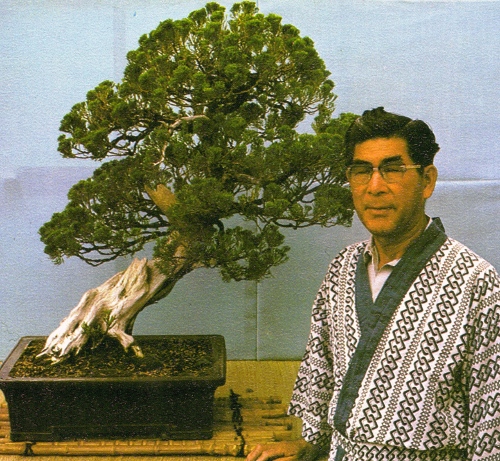
George Yamaguchi with his "Thundercloud" (Juniperus chinensis 'Torulosa'), 1974. Propagated from a cutting, this 20' tall landscape material was cut down in 1957 to about 24" because George was intrigued with the beautiful curve of the trunk. Further branch development, trunk sculpting and root trimming developed this into a bonsai. (Juyne M. Tayson, M.D. (ed), International Bonsai Digest Bonsai Gems, Fall 1974, pp. 31, 95) 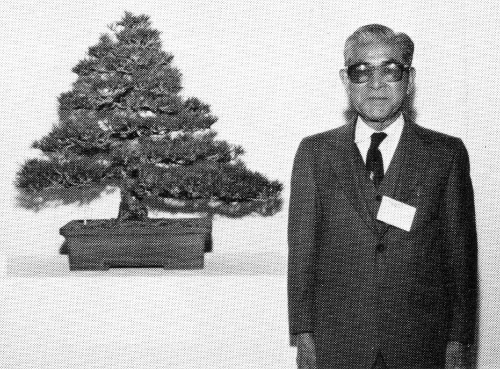
"George Yamaguchi's beautiful Black pine, grown and trained from seed germinated in 1956 [sic]
( "Yamaguchi Bonsai Nursery,"
http://www.bonsaichat.org/forums/showthread.php?t=145
; "George Yamaguchi North American Garden,"
http://www.bonsai-nbf.org/gardens/yamaguchigard.htm
; Godbey, Christina V. "Out and About / Yamaguchi Bonsai Nursery: A Yen for Miniature Trees," March 3, 1994,
Los Angeles Times,
http://articles.latimes.com/1994-03-03/news/we-29289_1_yamaguchi-bonsai-nursery
; Feld, Tara "Yamaguchi Bonsai Nursery," My L.A. Lifestyle,
http://mylalifestyle.com/2011/06/yamaguchi-bonsai-nursery.html
) SEE ALSO: Jan 15, Oct 15.
by Yamaguchi, was named 'Shinsei' meaning 'Voice of God' [15th January 1989]." ("Bei Koku Bonsai Meigo Kai Naming Ceremony," Bonsai Magazine, BCI, Vol. XXVIII, No. 2, March/April 1989, pg. 17) 2011 -- Momcilo Peter Voynovich of Evanston, IL died at the age of 87. (He was a professional photographer and became involved with bonsai in 1972. He built up a formidable collection of trees at his home. He was a president of the Midwest Bonsai Society. "The ultimate shaping and dwarfing are attained through relatively simple techniques, but they do require green thumb patience and discipline," Voynovich was quoted as saying. Outstanding American Bonsai (Timber Press, 1989), features superb color photographs by Peter of trees selected by 50 American bonsai artists as the best representation of their work as shown at the International Bonsai Symposium held in Minneapolis in 1987. The text is by Randy T. Clark of Minneapolis, vice president of the National Bonsai Foundation. Peter's wife Nidia preceded him in death by five years.) ("Momcilo P. Voynovich"; Kozelka, Art "The Mysteries Of Ancient Bonsai Take Shape At The Chicago Botanic Garden," Chicago Tribune, August 12, 1990; Chicago Botanic Garden 2011 Annual Report, pp. 28, 36, 37; "NIDIA M VOYNOVICH" in "Persons born on 10 May 1928"; "MOMCILO P VOYNOVICH" in Persons born on 2 January 1923.) SEE ALSO: Jan 2 |
||||
| 2 |
1908 -- Tsukinowa Yusen was born as Kato Goichi in Tagimi-city of Gifu Prefecture,
Japan. [He would dream of being a painter and would move alone to Kyoto to study while working
in the studios of the Kiyomizu ware studio.
After becoming increasingly interested in pottery, he would study under Sekikoku Soma, learning both pottery
painting and ceramics at large. He would be forced into hard labor during the Pacific war, and as a
result would struggle with poor health for the rest of his life. Bonsai would be a hobby for him, and
in 1960-61 he would begin making pots for his own trees. His painted pots would represent the pinnacle
of bonsai pottery painting technique, and today, it is estimated than only a hundred or so exist. Before
Yusen there would be almost no painted bonsai pots in Japan. Many of Yusen's pots would have elaborate
painting of village scenes. When a purchase would be made of one his pots not only would a bonsai pot be
gotten but often one would be buying four paintings as well. He would be most famous for his versions of
Ando Hiroshige's "53
Stations of the Tokaido Road," though other well-known motifs would include the famous
anthropomorphic animals of the Kozan
temple, mountain landscape scenes, water scenes featuring birds, and pictorial scenes of famous poetry.
Yusen would be a potter famous for his intricate and elegant painting of shohin bonsai pots,
particularly in both red and blue. Not only would Yusen be famous for his own work, but he would be one
of the most famous collaborators in bonsai pottery history as well. Collaborations between Yusen and
Sei-fu Yohei would be most famous and often seen, as sometime around 1971-74 he would live with Sei-fu and
develop a partnership where Yusen would make the ceramics and Sei-fu would paint them. Other collaborative
pots would abound as well, notably with Kutani Ikko. In Japan valuable pots would come with a wooden
case made to the size of the pot. The case would be marked with the maker's stamped rakkan and
calligraphy would be used on the case to describe the characteristics of the pot inside. The pot itself
would be wrapped in a yellow cloth, again stamped with the rakkan of its maker. Such a wrapping
and wooden case would only come with very valuable pots. A stamped cloth and matching wooden case would
add significantly to the value of the pot. Yusen would die in 1998. The 143 page book Charisma,
Yusen & Kouzan would be published in 2006 about the potters Tsukinowa Yusen and Heian Kouzan. A
very special small-sized bonsai display at the 4th US National Bonsai Exhibition in 2014 would feature the
work of Yusen.
"Yusen hard at work painting in his studio, circa 1980, 72 years old."
(van der Hoeven, Maarten "Special pots from Japan," Bonsai Focus, 4/2008, July/August, #116, pg. 86;
Tsukinowa Yusen-Part 1,"
japanesebonsaipots.net, Mar 9, 2013 with color photos of many of Yuusen's pots, and
Part II, with additional photos;
Edge, Sam, "Bonsai
Pots -- Tsukinowa Yusen, Sam & KJ's Suiseki Blog, Jan 10, 2011; Edge, Sam,
"Kouzan
& Tsukinowa Yusen -- Bonsai Pots," Nov 19, 2011 with several photos; Dupuich, Jonas,
Yusen display at the US National Bonsai
Exhibition, Bonsai Tonight, October 17, 2014) SEE ALSO: Apr 28
(Photo from japanesebonsaipots.net article, "Tsukinowa Yusen-Part 1") 1923 -- Momcilo Peter Voynovich was born. (He would become involved in bonsai and be most famous as a photographer thereof.) ("MOMCILO P VOYNOVICH" in Persons born on 2 January 1923.) SEE ALSO: Jan 1 |
||||
| 3 |
2020 -- California artist Mel Carrillo's donated legacy Kingsville Boxwood (Buxus microphylla 'Compacta')
in an early Sara Rayner slab-built ceramic made it to the bonsai court today, as part of the Huntington Botanical
Gardens' permanent bonsai collection in San Marino, CA. (The
tree was started as a select cutting in the 1960's by the East Coast area teacher Keith Scott, who then
gave it to his student, Dale Cochoy, as a gift in 1985. Sara mentioned that this pot was her
first attempt at a slab rectangle and was sold that same year to Dale at the "Magic in Memphis" Bonsai Clubs
International convention in Memphis, TN in May 1992. In early July 2018 Dale sold the boxwood along with
the balance of his bonsai and pots to Joseph Freeman. Shortly after Dale's passing at the end of 2018, Mel
acquired the boxwood in the pot from Joseph. Mel had started studying bonsai under sensei Roy Nagatoshi
in May 2017. Mel had also enjoyed studying bonsai at the Huntington and learning from Ted Matson. Ted
had joined the staff in February of 2015 (after several years as a consultant) to oversee the more than 400
miniature trees that make up the bonsai collections. About 70 trees, designed by masters of the art form,
are on display at any given time in the Bonsai Court of the Japanese Gardens there. Mel asked Ted if
he would consider accepting the Kingsville Boxwood and one of Mel's first collected California junipers
(Juniperus californica) for the Huntington's collection. By chance, Ted was
looking to add a chuhin-sized (roughly 14-18" or 35.5-45.75 cm H) California juniper, and couldn't pass
on the opportunity to also add the legacy Kingsville Boxwood, which is now the only one in the collection.
The Sara Rayner pot is 14.5" (36.8 cm) L x 5.5" (14 cm) W for the 16.5" (41.9 cm) H tree.) [At its new home it would be appreciated by the public and expertly cared for by the amazing volunteers under Ted's oversight.] 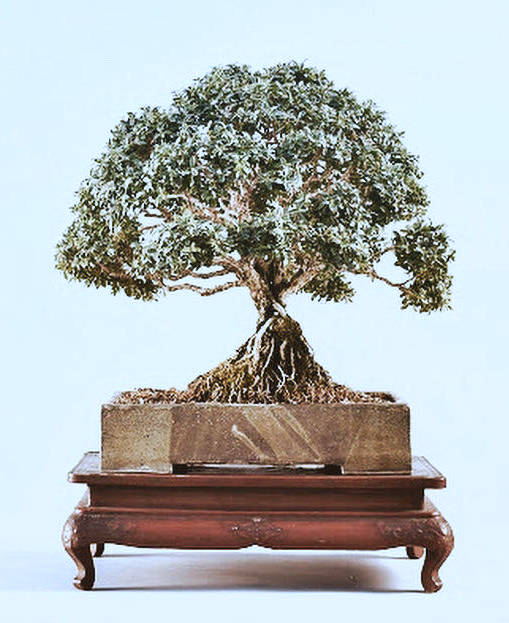
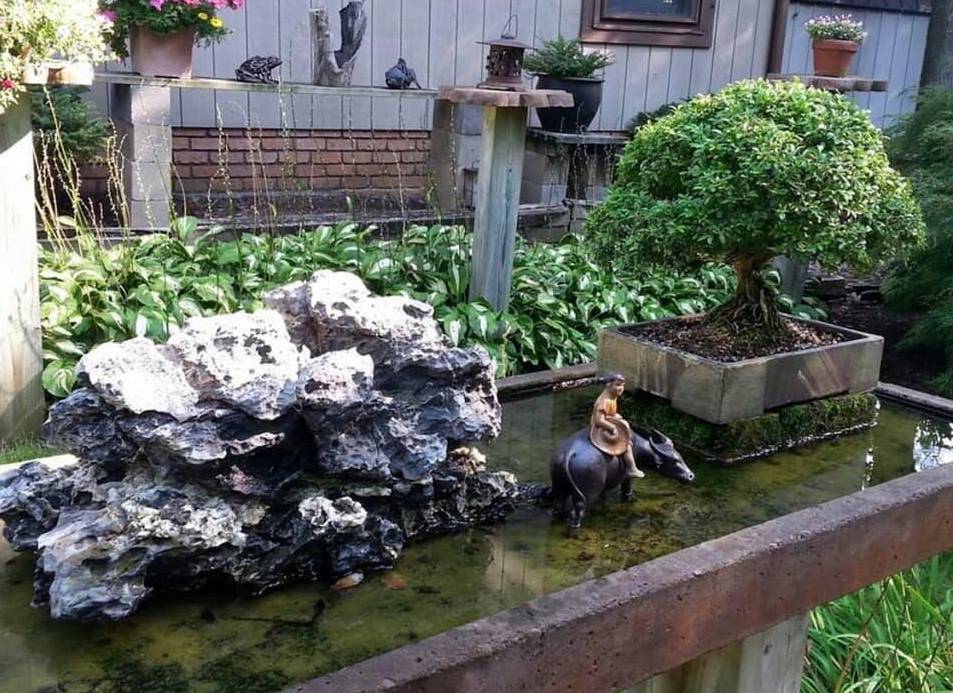
The Boxwood at Dale Cochoy's Garden, 12-22-2104
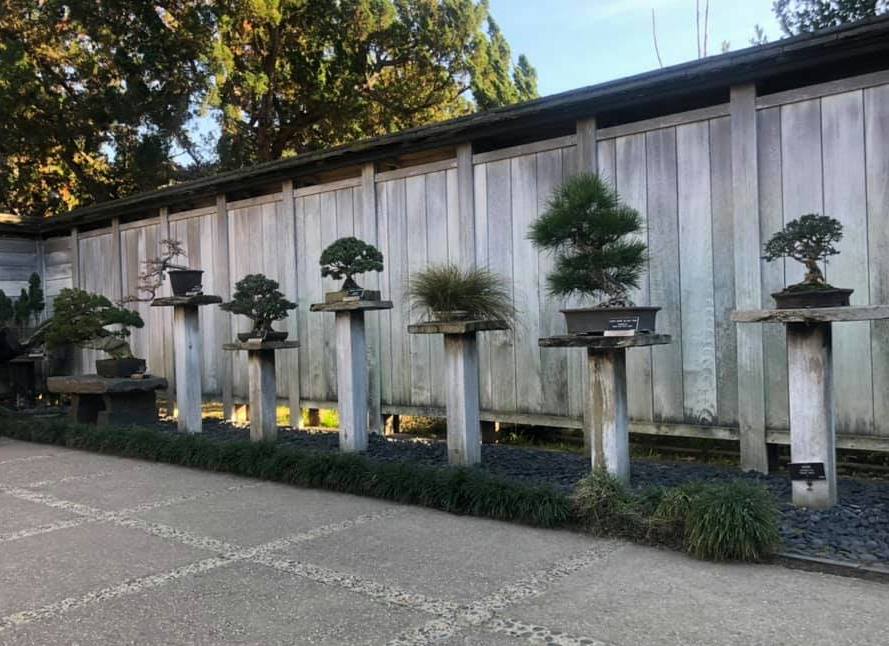
The Boxwood (4th from the right) at the Huntington, 01-03-2020
(Facebook posting by Mel Jan 03, 2020; FB Messenger texts and photos from Mel to RJB Jan 04 and Jan 05, including Jul 7,
2018 Bonsai Nut posting by Dale Cochoy and Jul 18, 2019 message from Sarah to Mel; Blackburn, Lisa
"A Prairie Boy's Passion for Bonsai,"
The Huntington, September 11, 2015) SEE ALSO: Feb 19, Apr 27, May 6, May 9, Nov 11.
|
||||
| 4 |
1883 -- A boy was born into the Taketa family. [As a young man he would develop
a keen interest in horticulture and bonsai. He would want to study under the guidance of Tomekichi Katō
of the Mansei-en nursery in Tokyo, but Katō-san would not want to have any students. Taketa would
persist and eventually be allowed to work and learn at Mansei-en. After two years of basic cleaning work he
would be allowed to care for the bonsai trees. Learning the techniques of grafting and wiring, he would begin
to creatively develop nice bonsai -- which he sold to Tomekichi. Taketa would eventually be allowed to marry
the nurseryman's oldest daughter, and he thus would assume the Katō family name.]
(Elias, Thomas S. "Mansei-en and the Kato Family: Part One," Bonsai Magazine, BCI, Vol. 40,
No. 3, May/June 2001, pp. 16-18) SEE ALSO: May 15
1939 -- Peter D. Adams was born in Portsmouth, over a hundred km southwest of London on the English Channel coast. [He would first become interested in bonsai in the mid-1950s while a junior art school student, during his twelve years' study of the Fine Arts. Because little was known about the garden art at the time in England, Peter naturally -- and correctly -- would borrow from his formal art training the concepts which he used in styling his miniature trees. As his career took shape, so would his understanding and use of bonsai techniques. He would graduate from Farnham School of Art. Professionally, he would become well-known for his portraits and landscape paintings after receiving his post-graduate degree from the Royal Academy of Arts in London, the oldest art school in England, the Royal Academy of Schools, Burlington House. He would go on to be an art teacher and experienced nurseryman, combining the two in over 50 years of experience in the field of bonsai. He would become heavily involved in the development and use of audio-visual teaching media. He would pioneer work with Scots pines in the United Kingdom. In 1977 and 1979 he would win the Gold Medal for his bonsai at the Chelsea Flower Show. He would be Life President of the Bristol Bonsai Society. As a worldclass teacher/artist, he would give demonstration/lectures and conduct workshops all over the globe. He would author several books on the subject, including The Art of Bonsai (1981), Bonsai Design: The Japanese Maple (1988), Bonsai Design: Deciduous and Coniferous (1988), Successful Bonsai Shaping (1993), The Art of Flowering Bonsai (1998), Bonsai Landscapes (1999), and Shaping Maples, Successful Bonsai Techniques (2007). He would also be on the editorial staff of Bonsai Focus magazine. His bonsai nursery in Surrey would give way to a residence halfway around the globe in Sequim, Washington, USA, about fifty km northwest of Seattle.] 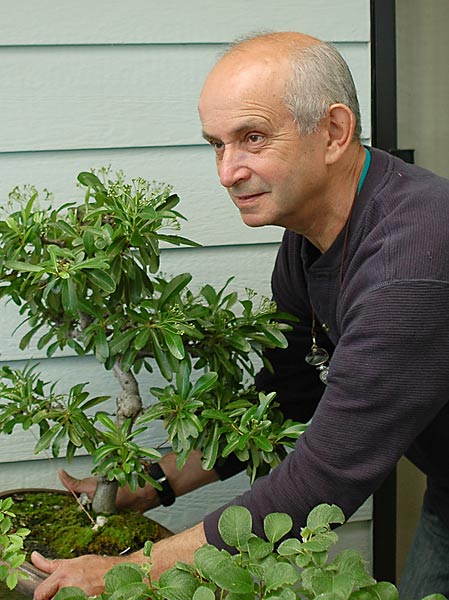
Peter Adams with pyracantha, 06/17/2006.
("Peter Adams -- USA," http://whoisbonsai.com/?p=311; Adams, The
Art of Bonsai, London: Ward Lock Ltd; 1981, 2nd edition 1990 dust jacket notes; Bonsai Magazine, BCI,
March/April 1985, pg. 20.) SEE ALSO: May 12, Jul 23, Sep 1, Sep 26, Oct 19, Nov 22,
Nov 24
(Photo by Walter Pall, courtesy of Alan Walker, 05/11/07) 1994 -- The Takagi Bonsai Museum opened in an ultra-modern nine-story building across from central Tokyo's Ichigaya Station. The project was the brainchild of then 67-year old Reiji Takagi (b. 1926), founder and president of Meiko Corporation. One of seven children from a wealthy banker's family, Takagi's contact with horticulture began at an early age as a sort of gardening assistant to his father. When he was 18, his house and garden were blown to bits during the Allied bombings of Tokyo in WWII. After two years of going back and forth between being penniless and prosperous (repairing nylon stockings), he came upon a windblown pine seedling on Shikoku Island in southern Japan. Seeing his life mirrored in the tiny creature tossed about by life's torments, Takagi placed the seedling in a pot and filled the container with nutritious soil. He watered his "special friend" twice a day, and began to learn more about the art of bonsai -- and, unconsciously, about business. Takagi's life began to improve, he turned his attention to selling the newly introduced copy machines, and in 1956 opened his first company office. As his business grew, so did his bonsai collection. He invented a paper shredding machine four years later, and that overnight success led to a recycling side business. By now, thanks to huge profits brought about by his expanding business, Takagi's bonsai collection numbered over 500 masterpieces. Some of the oldest and most esteemed of Japan's bonsai, often with documented histories, were purchased by Takagi for hundreds of thousands of dollars apiece. For three years, 1988-90, Takagi's collections won first prizes in Japan's national bonsai competitions, including Kokufu Ten. (He then took himself out of the running.) The nine-story building in 1994 allowed more room for both of Takagi's pursuits, bonsai and business. [Some of the 500 trees would be displayed on a rotating basis in the museum when not in the open-air rooftop garden. Additionally, rare ukiyo-e (woodblock) prints, hanging scrolls, and over 4,000 bonsai pots would be exhibited. His priceless collection was classed in the same special category as the Imperial Household's -- for presenting to state guests. And Takagi's "special friend" was now a superb bonsai, as radiant as its proud owner. [The Museum would close on October 31, 2004 to allow the trees to rest from the polluted Tokyo air for awhile after eleven years' display. The bonsai collection would be moved to the former Chikufu-en Bonsai Garden of Susumu Sudo located in Shimotsuke City where clear fresh air abounds. Reiji Takagi would pass away in 2007 and the Museum would be permanently closed a year later. The City of Saitama would then purchase 100 of the finest bonsai masterpieces and 200 containers and display tables from the Takagi estate to create the basis of a new venue, the Omiya Bonsai Art Museum, which would open in March 2010.] ("Tree Story" by Scott Lynn Riley in All Nippon Airways' Wingspan, Complimentary Magazine, November 1996, pp. 27-31; Katsu Ogiya in personal e-mail to RJB on Jan. 27, 2002; http://www.bonsaimuseum.org/e/; Valavanis, William N. "Omiya Bonsai Art Museum," International Bonsai, 2010/No. 4, pp.24-25). SEE ALSO: Mar 28, Apr 27 Sep 4. |
||||
| 5 |
1920 -- Kai Kawahara was born in Vallejo,
California. [When he was five years old, his family would return to
Kurume, Japan where he would grow up and go to
school. As a boy he would become interested in the art of bonsai and be taught the growing, collecting, and
styling of plants from his grandfather, who was particularly expert in grafting techniques. Formal studies
in the art would follow in the years 1935 to 1937. Kai would come back to the U.S. alone in Aug. 1937,
moving to Denver, CO in 1942. He would work for several years in
Granby, CO, about 85 miles or 137 km to the northwest
of the Mile High City at an elevation of 7,900 ft. There
he would learn much about trees native to the Rocky Mountains. Kai would meet his wife Susako when she'd
come to visit from her home in Hiroshima, Japan (about 134
miles or 215 km from his home there also in southwestern Japan), and they would marry December 22, 1950. They
would have two daughters, Amiko and Keiko. [Kai would be the first instructor for the Denver Bonsai Club when it would be organized in the early 1950s by seven other senior members of the Japanese community. He would hold that position for several decades. In 1977, when the Japanese garden section of the 22-acre Denver Botanic Gardens was being designed, Kai and Bob Kataoka, Harold Sasaki, Floyd Sunshine, Bob Krueger, Keith Jepson, Larry Jackel and Malcolm Correll would man the first flatbed truck collecting eight or ten pines that trip. The character Ponderosa pines (Pinus ponderosa) would be moved from nearby Estes Park by members of the Denver club. Permits would be obtained from the U.S. Forest Service to collect the 125 pines. The skeleton of the garden would be built around 800 tons of rock chosen from the mountains near Golden and Loveland. They would be placed to represent mountains and cliffs by the sea. "Japanese gardens encourage the use of native plants. We have about 50 percent natives in this garden." The two-acre garden would be begun in August 1978, and Sho-fu-en, Garden of the Pines and Wind, would be dedicated June 23, 1979. Kai would be a gardener there from 1980 to 1993, working to maintain the garden in the Japanese tradition as well as to incorporate into it trees native to the Colorado Mountains. In 1983 he would travel to Japan where, on December 12 of that year, he would pass the bonsai qualification tests of the Japanese Gardening Society and receive the title of "Master of Bonsai." He would die on December 23, 1998.] 
Kai Kawahara, Master of Bonsai, 1987
(Schedule for the Seventeenth Annual Bonsai Show of the Rocky Mountain Bonsai Society, June 13 - 14, 1987, copy
courtesy of Steve Alford of the Pikes Peak Bonsai Society; Persons born 05 January 1920 in the Social Security
Death Master File,
http://ssdmf.info/by_birthdate/19200105.html; "U.S.
Japanese Gardens," posted Oct. 11, 2012,
http://us-japanesegardens.com/tag/kai-kawahara/,
with two other photos of Kawahara, quote from Akiyoshi (Ebi) Kondo, Denver Botanic Gardens Senior Horticulturist;
"Shofu-en Japanese Garden,"
http://www.jgarden.org/gardens.asp?ID=284.)
SEE ALSO: FebAlso, Mar 18, Dec 23.
(Photo by Carolyn Knepp, DBG) 2024 -- Frank Goya died at age 100. (He was born in California's Imperial Valley in 1923, and spent some years in Japan as a child. He and his family came back to the U.S. prior to WWII. He served in the U.S. Army during the war, after having endured with his family living in a Japanese-American detention camp between 1942 and 1946. After the war, he served in the military in Japan and Korea, and then he returned to California. During this time, there was still a lot of hatred for Japanese in the U.S. It was hard to find work, so you had to work for yourself, and therefore Frank became a gardener. "I started [learning] in 1958... from John Naka about the same time as Ben Oki. John Naka's son and my wife's brother were friends and I really wanted to learn bonsai; so one rainy day, I visited John and he showed me his collection and I was amazed. Also around that time, the Gardeners' Association that I was a member of started a bonsai class, so I attended classes there, and that's how I got hooked. The only place to buy bonsai tools back then was the Baikoen Nursery of Frank Nagata. When John first went to the mountains he dug small trees, following Frank Nagata's preference. But John found that the bigger trees were better, so he started digging the big junipers. John never did anything half-way; he practiced long hours at that time with individual shapes until he was satisfied." Frank Goya learned from John that bonsai has a beginning but no end. It is a continuous process of trimming, shaping, watering, pondering. Like John, Frank had an intense dedication to his art. He was a patient teacher and also devoted much time to bonsai organizations, including his tenure as president of the California Bonsai Society for three years straight in the 1990s. Frank originally worked with junipers, then black pine and other species. He liked procumbens nana juniper because it grows compact and fast, and he used it frequently in his wonderful signature saikei. He was considered to be the number one practitioner of saikei, as well as one of the top 5 bonsai masters in the United States. Frank did a juniper saikei demo in February 2014 which was can be seen here. (The creator of saikei, Toshio Kawamoto, had a small class in Tokyo. His father was a famous bonsai man so their family was respected in the bonsai community. On one of his visits to the U.S., Frank and his wife, Margaret,attended Toshio's workshop at a convention in L.A., and that is when Frank first got to learn from him directly. Then at the First World Bonsai Federation Convention in Tokyo in 1989, Frank got to spend more time with Toshio and Tom Yamamoto, a teacher at his Nippon Bonsai-Saikei Institute. Tom was a G.I. from Hawaii. While stationed in Japan, he fell in love with the place and relocated there to be with his Japanese wife, and to study bonsai. Kawamoto had a garden on top of the building where he lived, and he gave Frank and wife a tour, in the rain, of his beautiful bonsai collection. In addition to Tom, he also taught another American named Masahiro Furukawa. When someone in the U.S. was interested in saikei, Kawamoto would send them to Masahiro who lived in Oregon. (Frank said "Bonsai can actually be a very expensive hobby -- good material, pots, tools -- and if you don't take care of the trees, they die. People think bonsai is something that doesn't last long and that they cost so much money. With saikei, you don't need to use older, developed trees, so you can create very beautiful scenery with inexpensive rocks, accent plants and younger trees. Because we live in Southern California, we have many beautiful rocks and stones we can use. Treewise, you can start cuttings or use nursery stock, and it only takes 3-4 years from cutting until they are ready, and you can use them for saikei plantings. Sometimes, you have to compromise with the tree. Sometimes, the tree has to compromise with you." A demonstration Frank did returning to his first club, the Baikoen Bonsai Kenkyukai, with his student Jaime Chavarria in 2016 can be seen here. Frank conducted one of the 18 workshops -- Saikei Planting -- during the 42nd GSBF Convention "Bonsai Forever" in Riverside, CA in October, 2019. (His favorite trees were California juniper and oak. He thought grafted trees were okay, although John advised against them. He advised against using trees not suited to one's area because most could disappoint. He saw a tree's overall shape as its most important feature; if a tree didn't look as Mother Nature intended, he felt there was no real value because it was obvious that it had been crafted. Frank's masterpieces, whether collected big junipers or small saikei, reflected the quiet yet brilliant charm of his artistry. Even in retirement, the Goyas remained busy with the eternal cycles of bonsai. They enjoyed the fact that it was a living art, but as in all of life, there was death There was an empty feeling when this happens, said Frank. "It's sickening [especially with trees that decline and could not be revived].") 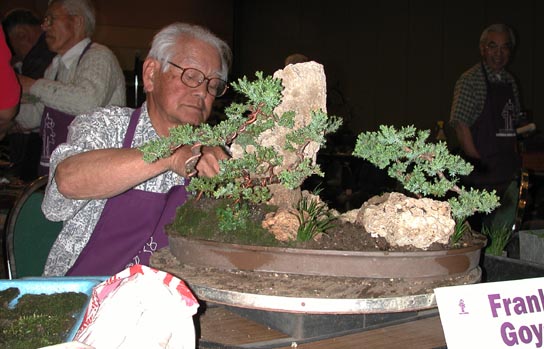
Frank Goya, saikei demo, 03/22/02.
(Announcement in FB 01/08/24
post by California Bonsai Society; "Member Spotlight: Frank Goya," The Dai Ichi Gazette,
December 2014, pp. 5-6.; Somerfeld,
Sharon "The Iron Men of Naka," Golden Statements, Vol. XXXV No. 2,
http://www.gsbf-bonsai.org/magazines/2012/v35_02.pdf,
pg. 24; Noriyuki, Duane "The beauty in bonsai," Los Angeles Times, January 30, 2003,
http://articles.latimes.com/2003/jan/30/news/wk-stay30;
"Workshop Leaders," Golden Statements, Winter 2020, Vol. 43, No. 1, pg. 19; Facebook PM from Jaime Chavarria
to RJB, Jan. 18, 2024) SEE ALSO: Jan 15, Jan 26, Apr 8, Nov 5
(Photo courtesy of Alan Walker, 05/11/07) |
||||
| 6 |
|
||||
| 7 |
1921 -- E. Felton Jones was born on a farm in eastern North Carolina. [He would
be the first of three boys in the family, and would be educated at Duke
University where he would major in botany and minor in zoology and geology. Although he would become
interested in bonsai at age 14, he wouldn't actually start studying it until the mid-1950s when Frank Nagata of
Los Angeles would take him in as a student. Studying with John Naka then, Felton would leave California in
1960 after six years and move to Matthews, NC. There he would open the Sho-Ko-En School of Bonsai, moving
the school to Atlanta at the start of 1967. In 1964 he would found the Bonsai Society of the Carolinas.
He would lecture/demonstrate at a number of conventions, including the American Bonsai Society in 1969, 1970, 1971,
1975, and 1979 (the last two being joint with Bonsai Clubs International, for which he'd also do the 1971 and 1981
Symposiums.)]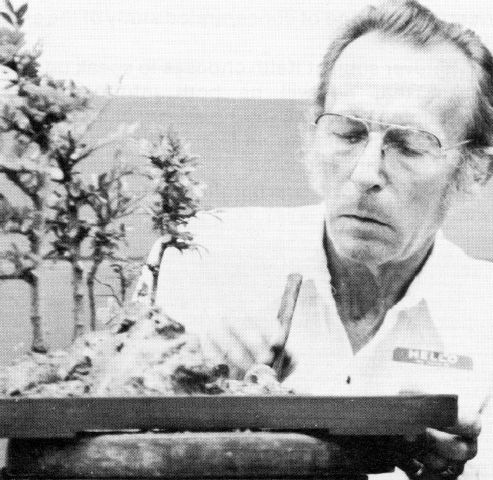
E. Felton Jones
(Dillon, Jim "Sokumenzu - Profiles," Bonsai Magazine, BCI, Vol. XI, No. 9, November 1972, pg.
20) SEE ALSO: Apr 4, Apr Also, Aug 19, Nov 15.
(Bonsai Magazine, BCI, September/October 1984, pg. 19) |
||||
| 8 |
|
||||
| 9 |
2002 -- Kay Cheever died. (Born in 1948, she was a lifelong resident of Brookings, SD,
Kay was formally educated as an artist. Some of her fabric/fiber art resides in the
South Dakota Art Museum,
and she was a long-time student of spinning, natural dying, and weaving. She was also
a poet and an author. As a civic activist, she was devoted to many local and national
causes, including the local Arbor
Day Committee and was a supporter of Global Releaf.
Her interest in trees began as early as she could sit up. She would be left in a "Teeter Babe" in
the shade of a weeping birch planted by her father and watch the leaf movement for hours. After
bringing home a Sunset book about bonsai, Kay enrolled in a beginning bonsai class in 1975. She would
go on to grow a variety of bonsai in the same home and yard where her fascination with trees began
years earlier. At least nine articles by her were published in the ABS Journal.
She was a director of the American Bonsai Society.
Kay was beset by physical and visual disabilities, and eventually had a kidney transplant. She
continued to find bonsai rewarding because it brought the tree tops within reach.)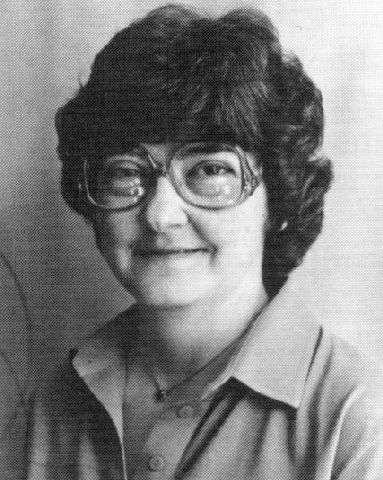
|
||||
| 10 |
1871 -- Chiyokichi Takahashi was born in Hiroshima, Japan. [He would first learn bonsai as a
boy in his native land. Coming to the U.S. in 1895, he wouldn't find naturally dwarfed trees that suited him. So he
would develop his own process of raising the trees from seeds. He would become a qualified tailor, later returning to Japan
and marrying a graduate of the Friends School in Tokyo.
Together, with her knowledge of English, they would return to California, establish a tailor's shop, and start a family
with 12 children born between 1901 and 1922. In 1927, he would develop trachoma
and no longer be able to continue his trade. To occupy himself, he would send for seeds from the Yokohama Nursery in Japan
and thereby would start his collection of bonsai. With time on his hands, he would plant one tree after another, purchase a
carload of pumice and proceed to carve thatched houses to accompany his plants. These arrangements he would call hakoniwa
(boxed miniature gardens) since he would not be adhering strictly to the classical lines. Many an afternoon would be spent
in pooling the experience in the various aspects of bonsai training of the two other Japanese men with the same interests: Frank
Nagata, who later moved to Los Angeles, and Homei Iseyama. Takahashi's lifelong hobby would become a thriving business in
1940, and his fame spreading through magazine articles (including the May 1950 issue of
The American Magazine). Strangers from the East Coast would
visit his backyard nursery and purchase his plants. [During the war years, he would rent his home with the understanding that the trees would be watered. When he'd return, half of his trees would be dried out and the remaining would have grown to jungle proportions. Exercising great patience, he would begin to reduce the latter to miniature size. [Now, in 1946, Earl Donovan would see the "Treasures of Japan" display at the De Young Museum in Golden Gate Park, San Francisco, CA. This would be a major national collection of art which Japan would send in honor of the signing of the peace treaty the year before. At dinner with some acquaintances, he'd remark "The art treasures are terrific, but if I ever become a millionaire, it is the bonsai I would like to have" -- the single bonsai shown would have been at the entrance to the exhibit. This maple tree would remind him of the tree he used to climb in his grandfather's back yard. "But you do not have to buy a great painter's masterpiece. You can buy a sketch." His dinner partners would tell him he might be able to buy a bonsai from a man in Berkeley. Going to the address suggested, Donovan would find that place terribly run down, its only adornments some ten-foot-tall pine trees which were shaped, graceful, and silent. As he was about to leave, the owner, Mr. Takahashi, would take Donovan behind the house to his bonsai collection. Here would be skeletons of trees -- trident maple and birch -- which would be surviving relics of the man's relocation to the Manzanar camp. He would sell Donovan a young maple bonsai which the latter would somehow got safely back to Los Angeles. His search for someone to take proper care of the tree would lead a week later to Frank Nagata. Nagata would be organizing a bonsai class and invite Donovan to join. [And so by 1950, Takahashi would have grown over 17,000 dwarf trees, some only 2-1/2" high. Professional growers and hobbyists from all over the country would beat a path to this man's door to buy trees and learn his secrets. He would often tell his family that he poured his soul into each of his bonsai and would sell only to those he knew would care for them and carry on with the same "tender loving care."]
(Chiyokichi Takahashi; "Stunt Man," The American Magazine, Vol. CL, No. 3, Sept. 1950, pg. 54 with b&w photograph by Graphic House; Suzuki, Grace "A Tribute To My Father," Bonsai Journal, ABS, Vol. 9, No. 3, Fall 1975, pg. 66 with b&w photo; Ferguson, Paul "How They Got Started," Bonsai in California, 1989, Vol. 23, pg. 40, which said the tree Donovan climbed was in his father's yard; "About the Author," International Bonsai Digest Presents Bonsai Gems, Fall 1974, pg. 41, which states that "The very next day Donovan went to Berkeley. He was overwhelmed with the beauty of the small Japanese garden when he found Mr. Takahashi. After a while, it was evident to Earl that he was failing to establish a rapport with the elderly gentleman, for the conversation was mainly a monologue on Earl's part. Just as he was taking his leave, Mr. Takahashi smiled and said that perhaps he would sell him a bonsai after all. Donovan chose, of course, a small Japanese maple."; Donovan, Earl H. "The Cost Factor," Bonsai in California, 1975, Vol. 9, pg. 43) SEE ALSO: Jan 31, Feb 7, Apr Also, Dec 24 1984 -- California master Ben Oki was given a tour of the numerous greenhouses at Union Correctional Institution in Raiford, Florida, one of which was devoted entirely to bonsai. Here he saw the great variety of plant material, the numerous styles employed, and the inmate-made containers being used. Ben selected a number of bonsai to take to the education building, where he critiqued and then made refinements on them. This was followed by a slide presentation of his own bonsai collection, which was punctuated by appreciative “oohs” and “aahs” from the audience. The final part of the program was his creation of a three-tree bonsai. No audience was ever more attentive, and none more appreciative, and Ben seemed to sense that this was a very special occasion for everyone in the room, inside these walls. He rose to the occasion magnificently, and produced a presentation which lasted over eight hours, and which was truly memorable. [The first year Ben accepted a check for his workshop fee, but for the next 19 years he has not accepted any money. Every visit usually starts with a demonstration or slides followed by a long workshop with every man a hands-on participant (about 20).] (The members of Taki Bonsai Society of Lake City had made a visit in 1983 to the Horticulture Division of the U.C.I. In touring the dozen greenhouses they discovered there was one that was devoted entirely to the training of Bonsai. The other eleven greenhouses grow all of the ornamental plants that are shipped to all of the offices of the State of Florida. Some of the inmates under the guidance of their Supervisor, Mr. M.B. Jordan had been working on the bonsai for years. Mr. Jordan had encouraged the bonsai efforts of the men. He felt that he could help them to better their knowledge of God’s creation and they would be better able to return to society and be a better person. Statistics show that prisons that have Horticultural Divisions have zero recidivism in prisoners paroled from that section. What does that say for horticulture and bonsai? The Taki Bonsai Society (which only lasted ten years) began to think of a way to make a link with the prison and the local bonsai group. As luck would have it, the Speaker’s Bureau of Bonsai Societies of Florida, which Jean Smith chaired, had an open day in the vicinity of the prison during the Ben Oki tour. Ben agreed, prison permission was gotten and everything fell into place.) (Hindson, Edna and Jean Smith and Harold Harvey ,"The Twentieth Anniversary of Bonsai Behind Bars," Florida Bonsai, BSF, Vol XXXV, No. 1, Issue 141, February 2005, pp. 28/18-32/20) SEE ALSO: Jan 26 |
